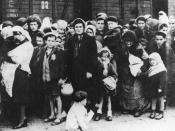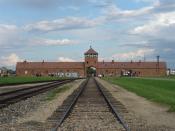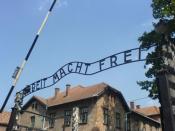"All over the world, Auschwitz has become a symbol of terror, genocide, and the Holocaust." Sixty years after the evacuation of the Nazi death camp, Auschwitz no longer is recognized for its years of hatred and death but for its liberation and the symbolic end of persecution.
Auschwitz was established in 1940 by the German forces occupying Poland in the city of Oswiecim. The orders came directly from Adolf Hitler and were fulfilled by Heinrich Himmler. Initially, Auschwitz functioned solely as a concentration camp, but beginning in 1942, it became the largest of the death camps. Those first brought to the camp were Polish political officials followed by Soviet prisoners of war, Gypsies, prisoners of various other nationalities, and more importantly, Jews. The death camps became Hitler's "Final Solution" to the Jewish problem.
Over the next few years, as carried out by Rudolf Höss, Auschwitz was expanded into three main camps: Auschwitz I, Auschwitz II - Birkenau, and Auschwitz III - Monwitz.
Along with the three main camps, more than forty sub-camps were founded and exploited prisoners as work slaves in various sorts of German industrial plants and farms. The camps were all isolated from the outside world and surrounded with barbed wire fencing. All contact with the outside was forbidden.
"Over time, the Nazis also began to send groups of prisoners from other occupied countries to Auschwitz. Beginning in 1942, Jews whom the SS physicians classified as fit for labor were also registered in the camp. After the selections, newly arrived persons classified... as unfit for labor were sent to the gas chambers: the ill, the elderly, pregnant women, children. In most cases, 70-75% of each transport was sent to immediate death. These people were not entered in the camp records; that is, they received no serial...



Newsflash
Auschwitz is still recognized for hatred and death.
2 out of 2 people found this comment useful.